11 Types Of WHITE WATER Birds (ID Guide With Photos)
Did you recently spot a white colored water bird? In that case you’ll probably want to know what species you saw.
Identifying the water birds that are white is not as easy as you might think, since there are many different types of aquatic birds that have white plumage.
To help you identify the bird you saw, we’ll cover the common white water birds of North America in this article.
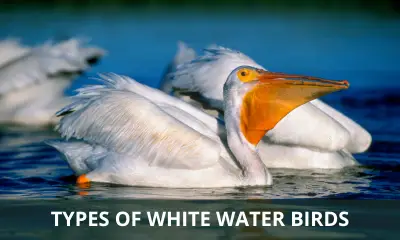
What types of water birds are white?
There are 11 types of water birds in North America that are white, which are described in full detail below.
Great Egret
Scientific name: Ardea alba
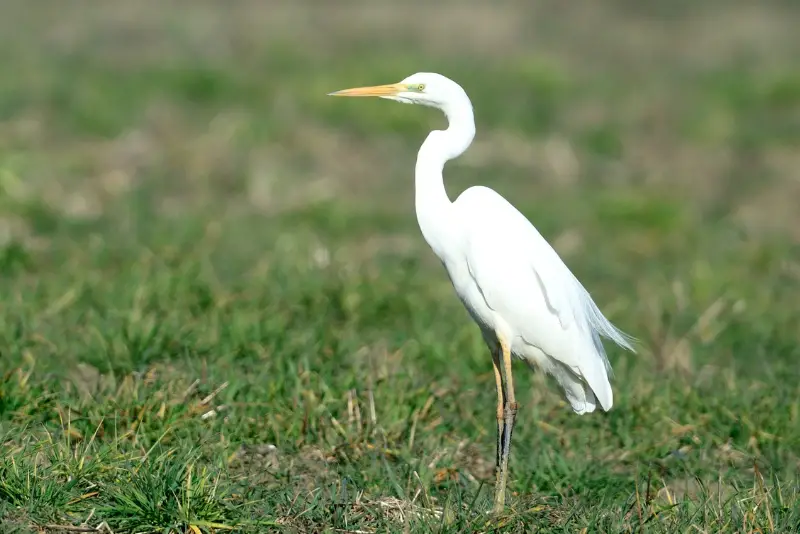
The Great Egret has a range that spans nearly the whole planet, and can be found on almost all continents.
This heron is a big white bird, except for its long black legs and feet along with a thick, yellow beak.
During the spring and summer breeding seasons, the Great Egret grows a plume on its back that extends all the way to the tip of its tail.
These white herons with long beaks forage in any type of shallow water, including ponds, lakes, rivers, estuaries, as well as rice fields and other flooded areas.
Cattle Egret
Scientific name: Bubulcus ibis
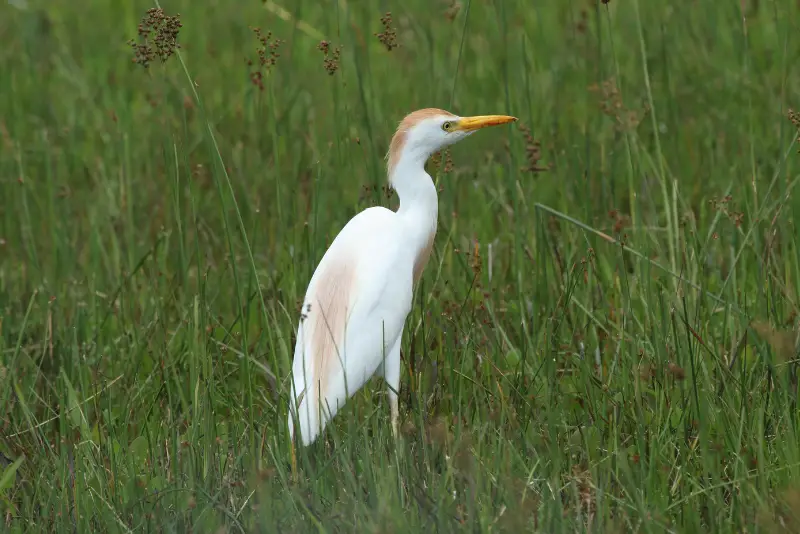
The Cattle Egret is a relatively new species in the New World that originated in Europe and Africa.
Nobody knows how these birds crossed the Atlantic, but they were first discovered breeding in Brazil, and later in Florida, where these birds first appeared in late 1955.
Cattle Egrets have been very successful at colonizing the Americas, and are now common breeding birds all over the southern United States.
This is a small egret that is entirely white, except for the breeding season, when adults develop orange plumage on the back of their head, back, and chest.
Snowy Egret
Scientific name: Egretta thula
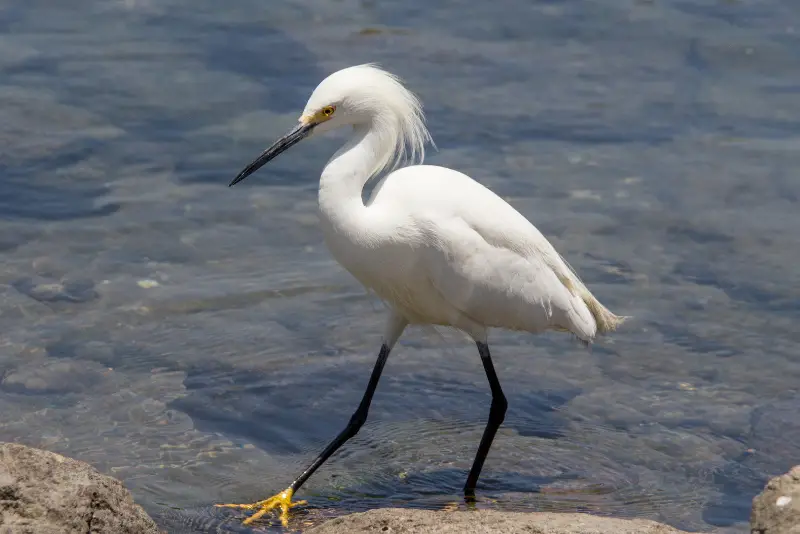
The Snowy Egret has become an increasingly common breeding bird all over the southern United States.
This is due to aggressive conservation efforts that were necessary because this Egret species was systematically hunted in previous centuries.
This little white egret stands out due to its slim black bill and bright area between the eyes and nostrils.
In adult birds, the feet are a brilliant golden yellow, while the legs are totally black. It is thought that the brightly colored feet help to attract small fish and other prey.
Little Blue Heron
Scientific name: Egretta caerulea

While adult Little Blue Herons are slate blue, young birds are entirely white during their first year.
Juvenile Little Blue Herons can be distinguished from other white herons by their dark bill and green legs.
These herons feed on small fish, mollusks and crustaceans, with crayfish forming a large part of their diet.
They prefer aquatic habitats, where these birds hunt in the shallows, and they are rarely seen away from water.
White Ibis
Scientific name: Eudocimus albus
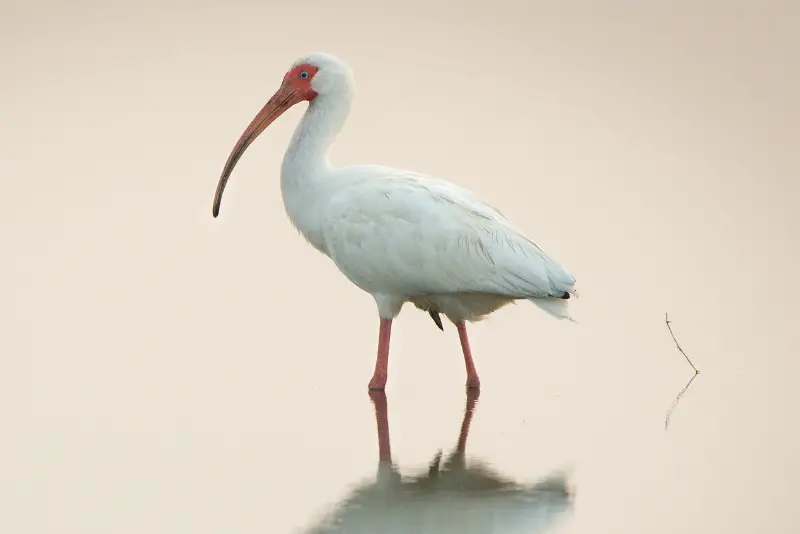
This white species is easy to recognize due to its generally white plumage and long vividly orange colored beak that is curved downwards.
During the first two years of their lives, immature White Ibises have a chocolate brown body with light streaks and a pale orange beak.
While it is most commonly found in coastal areas, the White Ibis prefers to forage in freshwater habitats.
This bird feeds on fish, insects, crayfish, and other crustaceans. Crayfish form a large part of its diet in areas where they are common.
American White Pelican
Scientific name: Pelecanus erythrorhynchos
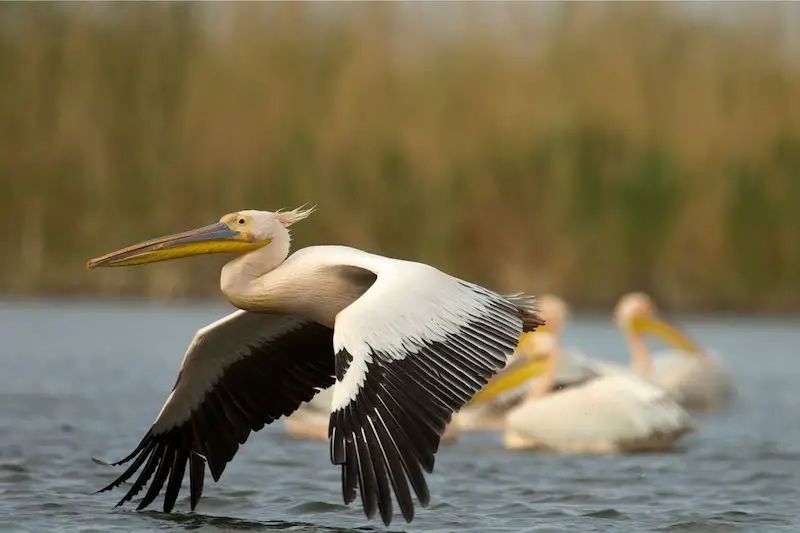
The American White Pelican is one of the largest aquatic birds in North America, and is almost entirely white, except for its black tipped wings.
These birds breed in the northern US, and spend the winter along the Gulf Coast, as well as in Florida and California.
This is the largest white-colored water bird in North America
With a wingspan of up to 10 feet, and a body weight of up to 30 pounds in males, the American White Pelican is the biggest white bird in North America.
This bird feeds almost exclusively on fish, but unlike other pelican species it doesn’t dive in order to catch them. Instead it submerges its head down into the water, and grabs fish with its large beak.
Their preferred habitat are estuaries, shallow bays, and coastal inlets, as well as freshwater lakes further inland.
Whooping Crane
Scientific name: Grus americana
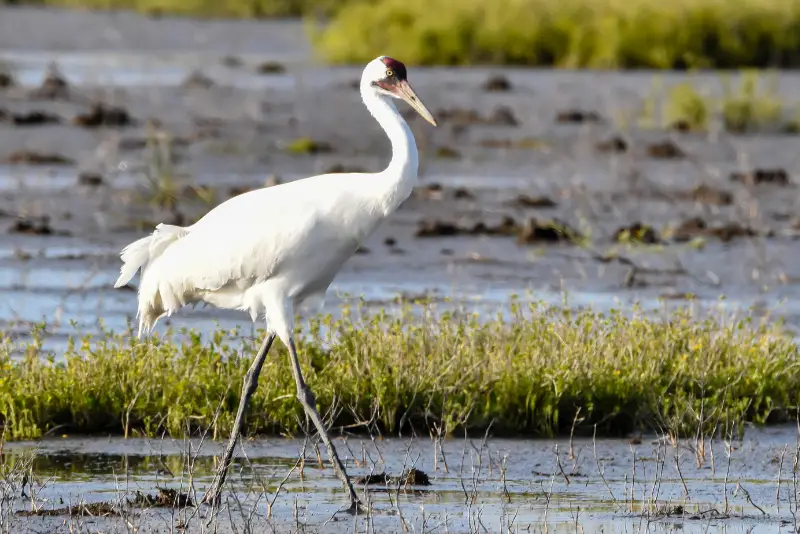
The Whooping Crane was a critically endangered species, and at the brink of extinction in the 1930s, with less than 20 birds remaining.
However, sustained conservation efforts have brought it back to a current population that numbers 600 birds.
Adult Whooping Cranes have a completely white body, with a red cap that consists of bare skin. In contrast to adults, juvenile birds have a reddish brown color.
Whooping Cranes breed in Alberta, Canada, as well as Wisconsin, and migrate south to spend the winter in southern states.
During the non-breeding season, the preferred habitat of Whooping Cranes are wetlands, marshes, estuaries, and salt flats.
Wood Stork
Scientific name: Mycteria americana
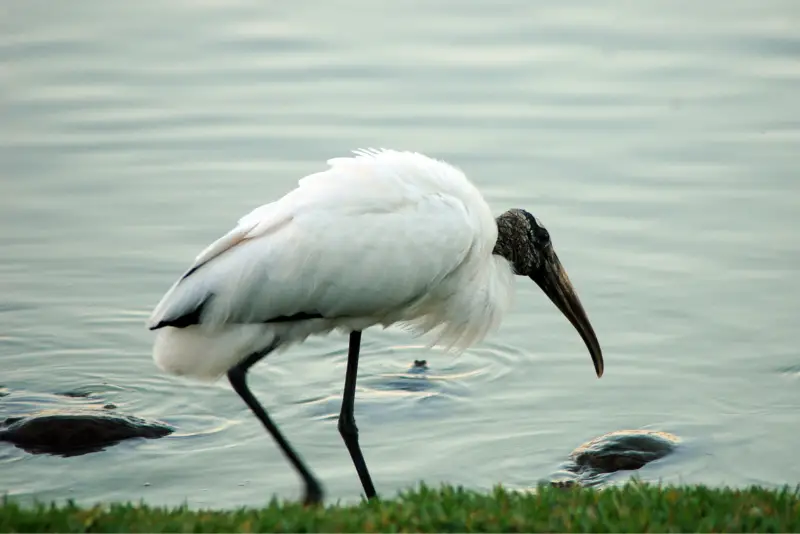
It’s easy to identify a Wood Stork if you can see it up close, due to its entirely white body combined with a bald, black head.
Similar to the White Ibis, the Wood Stork has a bill that curves slightly downwards. However, in contrast to the White Ibis, the Wood Stork has a black bill.
This black and white water bird is very large – similar in size to a Great Egret – but is easily distinguishable from the latter species by its curved beak.
Unfortunately, Wood Stork populations have been in decline over the past decades, which is a trend that it shares with many other wading birds.
Snow Goose
Scientific name: Anser caerulescens
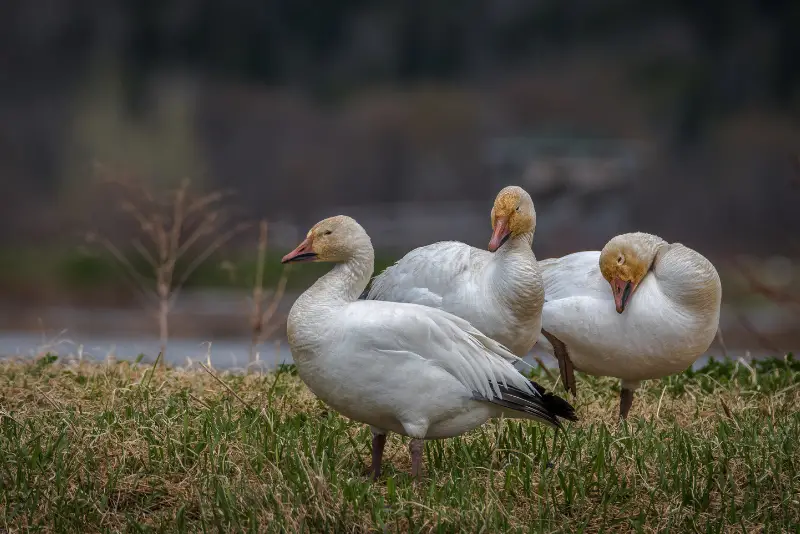
Similar to Trumpeter Swans, Snow Geese are winter visitors in the United States, but the number of wintering Snow Geese has rapidly increased in recent years.
The Snow Goose exists in two color morphs, one of which is entirely white, while the other is blue gray with a light cream head.
The Arctic population of Snow Geese has gone up significantly in the past few decades, and as result it is also much more common in its wintering grounds.
Snow Geese like to feed on harvested farmland, such as wheat fields, where these birds feed on leftover grains. In some cases these birds also forage on rice fields.
Trumpeter Swan
Scientific name: Cygnus buccinator
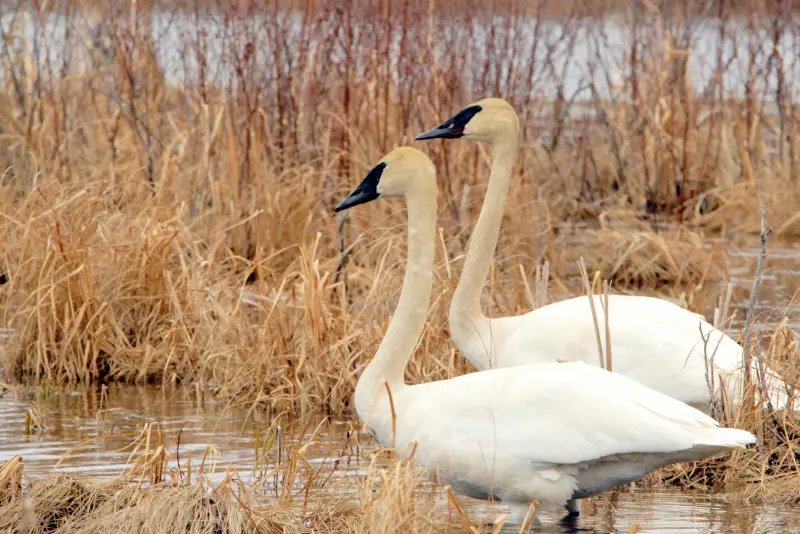
The Trumpeter Swan is a breeding bird of Canada and the northern United States, and is seen in the southern US as a rare winter visitor.
These huge swans are among the largest waterfowl found in North America, and adults are entirely white with a black beak, as well as a black area of skin between the eye and the bill.
Trumpeter Swans prefer shallow freshwater habitats, where they can use their long neck to reach their preferred food: aquatic plants.
In some cases these large white birds can also be seen foraging on rice fields or harvested farmland, where they feed on leftover grains.
Mute Swan
Scientific name: Cygnus olor

The Mute Swan is not native to North America, but has established numerous breeding populations here after being imported from Europe in the 19th century.
And while these invasive water birds are often frowned upon by local birders (due to their aggressive nature, which is thought to disturb the local fauna and flora), there can be no doubt that they are among the most elegant white birds on the planet.
Mute swans are very aggressive when defending their nest or chicks, and so you should give them a wide berth during the breeding season.
Tundra Swan
Scientific name: Cygnus columbianus

The Tundra Swan is a large breeding bird of northern Canada and northern Alaska. It is a winter visitor along the East Coast, where it can be seen from October through March.
These beautiful white birds are among the largest waterfowl found in North America, and adults are entirely white with a black beak. They can be distinguished from Trumpeter Swans by the yellow area of skin between the eye and the bill.
In contrast to adults, juveniles are pale gray with white streaks. These white swans feed in shallow water, where they use their long neck to reach for mollusks and aquatic vegetation.
Similar to geese, Tundra Swans also feed on leftover grains on harvested farmland.
Final remarks
In summary, here are the 11 types of water birds in North America that are white:
- Great Egret
- Cattle Egret
- Snowy Egret
- Little Blue Heron
- American White Pelican
- Whooping Crane
- Wood Stork
- Snow Goose
- Trumpeter Swan
- Mute Swan
- Tundra Swan
If you’ve spotted one of these while bird watching in Florida, but aren’t sure which species of bird it was, check our detailed bird identification guide above with photos.
If you enjoyed this article, check out our guide to the types of white birds found in Florida.
